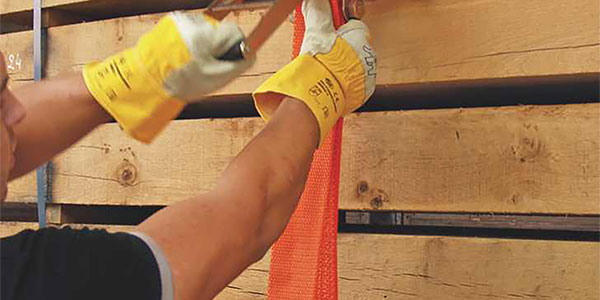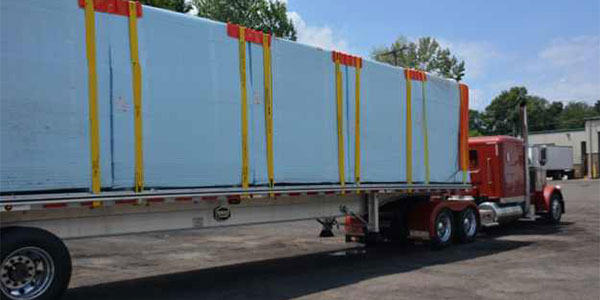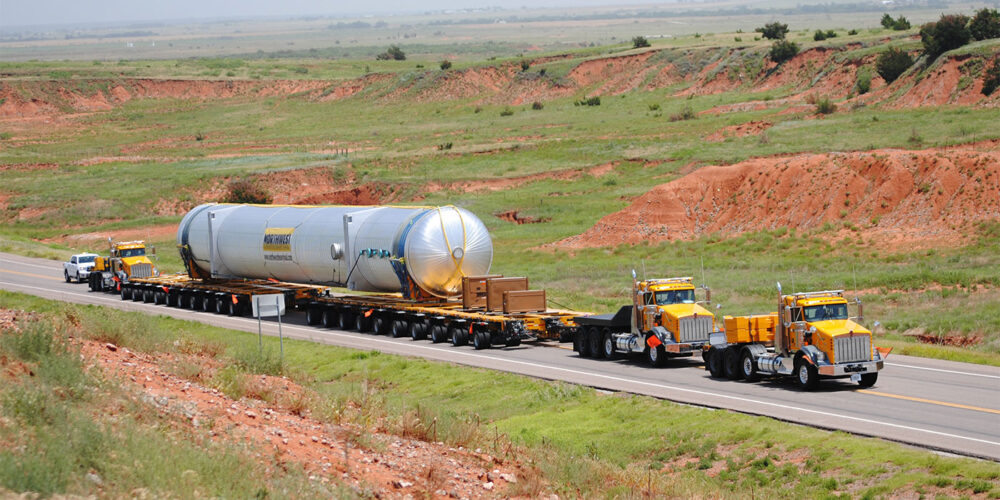Whether it’s a dry van, reefer, intermodal container or an open-deck trailer, there’s a lot to consider each and every time someone wants to load cargo into or onto a commercial vehicle, and then safely transport it from one place to another without damage or mishap.
Those who secure any payload to any commercial vehicle, often the vehicle’s operator, have to understand both federal laws and the laws of physics, and must be familiar with the characteristics of their cargo and the vehicle hauling it. They also have to understand that virtually anything they end up hauling could be considered cargo, including everything from the dirt clods that fall off a tracked vehicle, to spare tires, to tools and other equipment that come along for the ride.
As I’m sure you know, International Roadcheck 2023 is coming up fast. The annual inspection event is conducted by the Commercial Vehicle Safety Alliance (CVSA) to ensure the safety of commercial motor vehicles, their drivers and the public at large. During the event, inspectors will conduct thorough inspections of select commercial vehicles on the road, and yours could be one of them.
International Roadcheck typically lasts for three days, and this year’s event will begin on May 16 and end on May 18. The 2023 International Roadcheck will focus in part on cargo securement compliance. In this article, I’m going to review some critical information that can help you avoid the accumulation of CSA points or an out-of-service citation during this year’s Roadcheck – and maybe prevent a catastrophic event somewhere down the road.

The greatest hits
Let’s start broadly with the infractions that seem to catch most folks with their cargo pants down. We’re going to drill down a lot deeper, but my first piece of advice is to start here and make sure you don’t make one of these eight mistakes. By simply focusing on avoiding these most common infractions, you will reduce your chances of a problem significantly.
Based on the Federal Motor Carrier Safety Administration’s (FMCSA) data and analysis, the most common cargo securement violations for commercial vehicles in the U.S. are:
- Failure to prevent shifting or loss of load: This is the most common violation and includes issues such as inadequate tie-downs, loose or damaged cargo, and insufficient load securement.
- Failure to secure equipment and vehicle components: This violation includes issues such as loose spare tires, unsecured tailgates, and improperly secured ramps.
- Insufficient tie-downs: This violation involves using inadequate numbers of tie-downs or using tie-downs that are not strong enough (properly rated) to secure the cargo.
- Failure to secure heavy equipment properly: This violation includes improper blocking and bracing of heavy equipment such as machinery and vehicles.
- Failure to secure rolled paper properly: This violation involves improperly secured rolls of paper, which can cause shifting and instability during transport.
- Failure to secure metal coils properly: This violation involves improperly secured metal coils, which can roll and cause damage to the vehicle and surrounding traffic.
- Failure to use edge protection: This violation involves not using edge protectors to prevent straps or chains from cutting into the cargo.
- Failure to secure intermodal containers properly: This violation involves improper blocking and bracing of intermodal containers.
Please remember that interpretation is everything and as anyone who has ever received a ticket knows, the authorities have a lot of latitude and sometimes even a little attitude. Keep in mind that they have a tough job, just like you. So please be courteous, cooperative and considerate when dealing with everyone involved in an inspection, even if you disagree with a ruling.
This just in
According to my industry sources, there are a couple of areas that deserve special attention as we approach the May Roadcheck event. Again, I offer this advice as low-hanging fruit – the kind that should be avoided.
Apparently, the 10-foot tiedown rule is often getting folks into trouble. The standard says that there should be a tiedown every 10 feet. However, with some loads, a tiedown at the 10-foot mark is not practical or appropriate. So loads that are correctly secured, based on every other metric and rule, are being cited on the 10-foot rule. Apparently, this has been happening so much that CVSA has added a note in the Out-of-Service Criteria in the cargo securement section. I suggest you make a copy of the section and the note for reference and to support your position in any discussion with authorities.

It says: “NOTE: Position of tiedowns–If an article of cargo has the correct number of required tiedowns for length and/or weight, the US regulations/NSC Standard 10 do not specify where they have to be located on the article(s) of cargo.”
Folks are also getting into trouble because of a failure to periodically check and re-tension their cargo securement as prescribed in FMCSA 392.9 Inspection of Cargo, Cargo Securement Devices and Systems. By viewing an electronic logging device (ELD) an officer can see that a driver did not stop and check their load at 49.7 miles (80 kilometers) from the loading site, or after a change in duty status, or every three hours, or after the vehicle has been driven 149.129 miles (240 kilometers) as required. Drivers should be aware that they are leaving a digital trail and should perform the required cargo checks to make sure that trail doesn’t lead back to an infraction.
Here are some helpful links for the most up-to-date regulations in the U.S. and Canada: Federal Motor Carrier Safety Administration and Canadian Council of Motor Transport Administrators in Canada.
Knowing cargo securement inside and out
Now let’s focus on the two primary branches of cargo securement: internal cargo securement and external cargo securement. Internal cargo securement primarily relies on the wall structure of a box truck, dry van or refrigerated trailer to maintain cargo stability and support. External cargo securement must be used for open-deck, hydraulic, spread axle, tank hauler, lowbed, flatbed, gooseneck and ultra-heavy capacity trailers.
Each presents its own unique set of challenges and if done incorrectly, each can result in citations, CSA points accumulation or an out-of-service violation. I’m going to examine internal cargo securement first and then we’ll work our way out.
The inside scoop
If an inspector opens the doors of a truck or trailer and sees cargo that he or she deems improperly secured, you have a problem. Unfortunately, any pronouncement by authorities will likely be subject to broad interpretation. So let’s focus on some key features that will help keep you out of trouble.
Cargo securement regulations require cargo to be immobilized or secured within a vehicle. Immobile is defined as not moving or incapable of being moved. To actually immobilize cargo means to achieve an absolute absence of movement. Cargo is almost always secure by restraining and containing it and this means there may be some movement of the cargo, but there is no risk of it falling off or shifting enough to make the vehicle unstable.
Even medium-weight cargo could possibly develop enough momentum to penetrate the body panel of a vehicle. Movement of a large amount of medium-weight cargo could have an adverse effect on a vehicle stability or maneuverability.
When it comes to securing cargo in box trucks, dry vans or refrigerated trailers there are two key words I want everyone reading this article to remember. The first is “stability” because cargo has to be stable to be safe. The second word is “unity” which is a state of being united or joined. We create stability by joining cargo with the vehicle structure, including the floor with consideration of its friction characteristics, and/or with other proximal cargo. By connecting the cargo with the vehicle’s structural components and/or with other units of cargo, one can create a stable, unitized mass that is less likely to shift when in transit.
Let’s start with some basic best practices and procedures. One of the first considerations is distributing weight evenly, thus avoiding overloading one side and causing stability issues during transport. Heavier items should be loaded first and distributed evenly from side to side and from front to back.
Load the heaviest items on the deck of the truck or trailer and work your way up to lighter items. This will help to maintain stability and prevent top-heavy loads, which can be dangerous. Using pallets can also help to distribute weight evenly and make it easier to load and unload cargo.
As the cargo is loaded into the truck or trailer, generally starting at the nose, it needs to be incrementally stabilized before additional cargo is loaded behind it. Think of the process as if you’re building multiple tight, stable layers starting at the nose of the trailer and working your way back toward the door. Securing the first portion of the cargo tight against the nose will enable you to take advantage of the structural integrity of its two corners and three walls to set the stage for a stable, unitized load as you work your way out.
Restrain medium-weight loads by tight-fitting of the cargo within the space. This means that each article of cargo is in contact with, or very close to the vehicle body panels and/or other cargo. If there are spaces left and you have a concern about the cargo shifting, consider using dunnage as a void filler.
There are a variety of dunnage products that can be used for different applications. There are different forms of corrugated cardboard that have different strengths, foam dunnage is available, and airbags can also be inserted into spaces and inflated to provide a tighter pack.
Dunnage allows you to interconnect the load and unitize it. With dunnage, you’re immobilizing or stopping the cargo from shaking, moving forward, moving aft or moving laterally.
The most basic method or segregating layers includes a cargo bar or a jack bar to stabilize the load and prevent it from shifting. With light cargo, these types of bars may do the trick nicely.
The heavier the load, the more you’re going to want to use some type of strap assembly, generally a logistic strap, to secure cargo in place and keep it from moving. The logistic strap will attach to a logistic track generally incorporated into the wall of the truck or trailer. Track types may range from A-Track to E-Track to F-Track, depending on the vehicle.
The proper method is to connect one end of the strap to one wall about 18 inches behind the edge of the cargo facing away from the nose and then to connect to the opposite side of the trailer, again, 18 inches behind the edge of the cargo facing away from the nose. Envision looking down at the cargo from above and the strap should be in a “U” shape with the open part of the U toward the nose of the truck or trailer.
After being securely connected, the logistic strap can be adjusted for the proper amount of tension. The tension should be firm enough to keep the cargo in place without damaging it, so consider the cargo type and the strap placement in your equation.
Once your first nose-end load is secured, place the next load of cargo tightly against it, then repeat the process described above. Again, think layers. If you’re using a double-decking system of some kind to maximize capacity, simply apply the same reasoning to the second level.
When assessing any load, consider whether the cargo is likely to slide or shift when exposed to the dynamic forces of vehicle movement. Plastic wrapping can help keep some types of cargo more stable. Anti-slip mats come in a variety of shapes and sizes and can increase the coefficient of friction between the load and the deck. The application of blocks nailed into the decking is also a common solution to prevent sliding and can aid in cargo stability, particularly for palletized cargo.
Cargo that is tall and might tip over should be braced above the level of the deck. Bracing may be necessary and may include a wood frame built around the top of a tall unit of cargo in such a way that it can make contact with one or more of the vehicle walls.
When cargo consists of a mixture of cube weights, individual articles or groups of articles must be secured according to their weight category. You can also achieve a stable load by partitioning the cargo. Strapping lighter cargo against heavy cargo and/or medium cargo. Heavier cargo can also be blocked and positioned to immobilize lighter cargo.
Ralph Abato is the president and managing director of Doleco USA.














